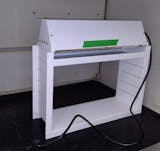Download a paper in regard to using the Analytik Jena CL-3000 UV crosslinker for disinfecting respirator masks here.
See a movie of the CL-3000 used for disinfecting respirator masks here.
International Ultraviolet Association (IUVA) fact sheet on Covid-19 here.

XX-Series UV Bench Lamp
Bench XX-Series UV Lamps offer a complete selection of models - fixture only or with a choice of the following wavelengths: longwave, BLB (black light blue), shortwave or midrange. Wavelength 352nm BLB tubes are available for the XX-15 fixture.

Main features
- Various fixture sizes, watts and wavelengths are available
- Lamps include holes on each end of the fixture for hanging or mounting the lamp
- Lamps are manufactured with a durable aluminum housing and powder paint scratch resistant finish
- Shortwave lamps can be used in an upward facing position for purifying air or in a downward position for sanitizing work surfaces
- 254nm UV can kill up to 99% of organisms from bacteria, yeast, mold spores, germs and viruses
- Shortwave UV (254nm) offer reliable and effective tool for sterilization and sanitation applications in hospitals, laboratories, pharmaceutical companies and clinics.
- UV intensity can be increased by bringing the lamp closer to object being sterilized

Hang the fixture for overhead UV illumination for growth experiments and sterilization (XX-15S shown)
Sterilization
When using shortwave UV, when you know the micro-organism to be destroyed and how much energy is required, divide the energy required (in units mW/cm2 at 12 inches for the XX-15S) to calculate the total exposure time required to do the job.

The XX-15 Lamp connects to the Exposure Stand for UV fluorescence experimentation.
BLB (Black Light Blue) Bulb
The 352nm BLB tubes can be used in inspection and testing applications. Note: BLB tubes are available only for the XX-15 fixture. The XX-40BLB (pictured below) provides a wide area of illumination when used with the longwave 365nm BLB tube.

UV Protection
UV-C's effects on the human body vary depending on length of exposure, but can cause painful burns on the skin. It can also cause temporary damage to the cornea if observed directly. Aside from these threats, UV-C is a known carcinogen for human skin. We strongly suggest using protective eyewear, face shields, and gloves when working with UV-C.




























